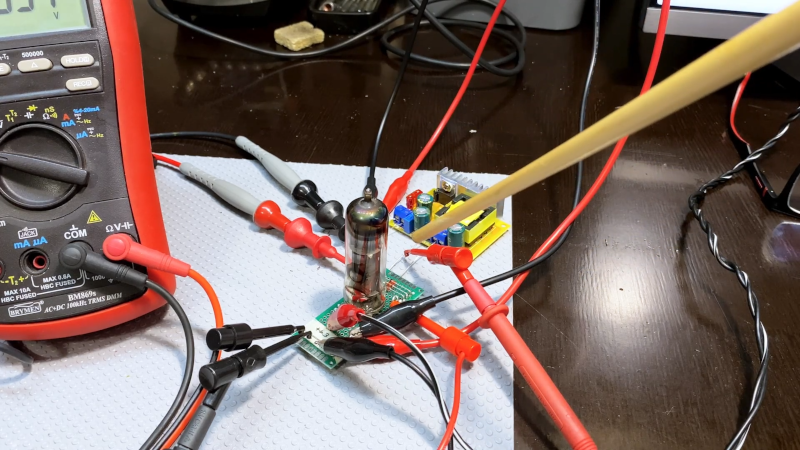[M Caldeira] needed to test a tube and didn’t have a spare to do the old swap test. He also didn’t have a tube tester handy. Drawing inspiration from a 2015 video, he managed to cobble up an ad hoc tube tester using stuff around the workbench. You can see a video of the process below.
To duplicate his effort, you are going to need a few meters. Good thing they are relatively cheap these days. Usually, a tube tester has a way to adjust all the different parameters for the tube, but there’s no reason you can’t just set those parameters using your testbench power supplies.
Of course, that’s going to require high voltage power supplies. You won’t be able to use a USB port to power most tubes. A simple test board provides the right bias and convenient ways to connect the power supplies. One supply powers the heater, while other power supplies drive the other voltages. A small DC to DC converter provides the high voltage B+ line from 12V input.
Watching the tube in operation is certainly one way to test it. The days when tube testers were everywhere are long gone. But you can still find some interesting ones on the used market if you really need to test a lot of tubes. If you are really motivated, you can even make your own tubes.















Most people didn’t have tube testers. They went to the radio store or the drugstore, or maybe the local repairman would let them use theirs.
But since tubes are mostly obsolete, the used testers are on the market. So way more hobbyists have them than in the old days. I was going to say there’s a glut, but prices stay high.
You can also try the method of,
Phase 1: take vacuum tube, holding it high walk into a drug store run by a white haired guy that’s been there since the flood.
Phase 2: ?
Phase 3: walk out with dusty old tube tester from the back storeroom to fix up.
But those were mostly good/bad testers, and rumor said they were weighted to sell more tubes.
Test a tube? Why would anyone do that? I just throw them out.
Drugstore tube testers were always meant to sell tubes to people who didn’t know beyond green-yellow-red markings on the meters. They were OK at telling you mu at some undisclosed parameters which I guess indicated which tube had completely failed. Many of the modem tubes use thoriated cathodes to increase gain which would boil off after time and was the primary cause of a tube going soft. You can vary the filament voltage (changing cathode temperature) to predict the future life of the tube. I’ve thought with variable voltage switched mode power supplies and raspberry pi s you could build a really spectacular tube tester that would spit out the complete family of curves on a graph in a few minutes. That would be really cool particularly at the cost of new tubes (and the Russian embargoes) today. It could take matching tubes to a new level.
This is certainly true. I own an inexpensive Peak DCA75 Pro semiconductor tester that displays a full set of curves on my computer, and there is no reason the same thing couldn’t be done for tubes. Just a bit more difficult to handle the higher voltages. https://www.peakelec.co.uk/acatalog/dca75-dca-pro-semiconductor-analyser.html
µTracer – a modern tube tester and curve tracer – is already available.
I use the v1 slot in my Fender VibroChamp
You really should not operate a tube at zero signal grid volts. In this state, it will conduct the maximum current it possibly can, and soon it could red-plate, plus you are really reducing its life. Tube testers are usually go/no-go tests. The tube specification sheet has Typical operating conditions, which is more realistic to test with. You are testing at Absolute Maximum ratings. At -7.3V on the grid, you should conduct 48mA anode and 5.5mA screen current at 250V plate voltage. For these reasons I test a tube in the equipment it is used in. You can also easily determine if bad components are swaying the voltages.
I’d suggest to review https://www.dos4ever.com/uTracer3/uTracer3_pag0.html or http://www.valvewizard.co.uk/valvetester.html. I have build the uTracer myself and it’s awesome.